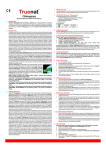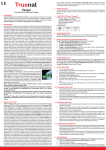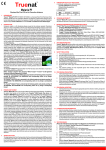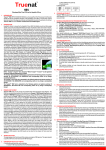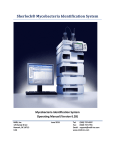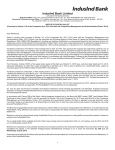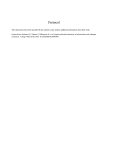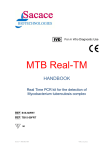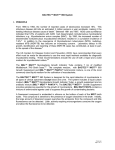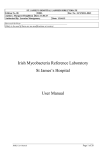Download Chip-based Real Time PCR test for Mycobacterium tuberculosis
Transcript
1. Truenat™ MTB chip-based Real Time PCR test for Mycobacterium tuberculosis. 2. DNase & RNase free pipette tip. 3. Desiccant pouch. B. Package Insert. MTB REF Chip-based Real Time PCR test for Mycobacterium tuberculosis 1. 2. 3. INTENDED USE Truenat™ MTB (REF 601030005 / 601030020) is a chip-based Real Time Polymerase Chain Reaction (PCR) test for the quantitative detection and diagnosis of Mycobacterium tuberculosis (MTB) in human sputum specimen and aids in the diagnosis of infection with MTB. Truenat™ MTB runs on the Truelab™ Uno Real Time micro PCR Analyzer. INTRODUCTION Tuberculosis (TB) is an infectious disease caused predominantly by the bacillus Mycobacterium tuberculosis. It typically affects the lungs (pulmonary TB) but can affect other sites as well (extra pulmonary TB). Tuberculosis (TB) is the second largest killer worldwide, after HIV and is the leading cause of death in HIV patients.Pulmonary TB spreads through air and is highly contagious. Over 80% of TB infections are pulmonary and if left untreated, a pulmonary TB patient can infect up to 10-15 other people through close contact over the course of a year.Due to the highly infectious nature of pulmonary TB, it is important to diagnose and treat the disease very early. Despite the availability of highly effective treatment for decades, TB remains a major global health problem mainly because of poor case detection. The most common method for diagnosing pulmonary TB worldwide is sputum smear microscopy. However sensitivity of direct smear microscopy is low and estimates range from 30% to 70%. It is even lower in case of HIV-infected patients. Culture is more sensitive than microscopy and is considered the current gold standard. Culture requires specialized and controlled laboratory facility and highly skilled manpower and takes 3 to 6 weeks to provide the result. Molecular techniques such as polymerase chain reaction (PCR) or Real Time PCR are much more sensitive than microscopy and culture. However PCR or Real Time PCR tests have so far been restricted to centralized reference laboratories as they require skilled manpower and elaborate infrastructure. Also the turnaround time for results could take a few days. The Truelab™ Real Time micro PCR System enables decentralization and near patient diagnosis of MTB by making real time PCR technology rapid, simple, robust and user friendly and offering “sample to result” capability even at resource limited settings. This is achieved through a combination of lightweight, portable, mains / battery operated Truelab™ Uno Real Time micro PCR Analyzer and TrueprepTM MAG Sample Prep Device and room temperature stable Truenat™ chip-based Real Time PCR test and TrueprepTM MAG Sample Prep kits so that even the peripheral laboratories with minimal infrastructure and minimally trained technicians can easily perform these tests routinely in their facilities and report PCR results in less than an hour. Moreover, with these devices PCR testing can also be initiated in the field level, on site. Truenat™ MTB is a disposable, room temperature stable, chip-based Real Time PCR test with dried down PCR reagents for performing Real Time PCR test for detection of Mycobacterium tuberculosis and runs on the Truelab™ Real Time micro PCR Analyzer. It requires only six (6) µL of purified DNA to be added to the reaction well for the analysis. The intelligent chip also carries test and batch related information including standard values for quantitation. TM The Truenat MTB chip-based Real Time PCR test also stores information of used test to prevent any accidental re-use of the test. NOTE : Truelab™ / Truelab™ Uno / Trueprep™ MAG / Truepet™ / Truenat™ are all registered trademarks of Molbio Diagnostics (P) Limited. The Truelab™ Real Time micro PCR Analyzer is protected by the following patents and patents pending: IN 2313/CHE/2007, WO 2009/047804 and corresponding claims of any foreign counterpart(s) thereof. The Truenat™ micro PCR chip is protected by the following patents and patents pending: IN 2312/CHE/2007, WO 2009/047805 and corresponding claims of any foreign counterpart(s) thereof. The Truenat™ MTB chip-based Real Time PCR test is protected by the following patents and patents pending: IN 796/CHE/2012 and corresponding claims of any foreign counterpart(s) thereof. PRINCIPLE OF THE TEST Truenat™ MTB works on the principle of Real Time Polymerase Chain Reaction. The DNA from the patient sputum sample is first extracted using Trueprep™ MAG Sample Prep device and Trueprep™ MAG Sputum Sample Prep Kit. Six (6) µL of the purified DNA is dispensed into the reaction well of the Truenat™ MTB chip-based Real Time PCR test. The Truenat™ MTB chip-based Real Time PCR test is then inserted into the Truelab™ Uno Real Time micro PCR Analyzer where thermal cycling takes place. A positive amplification causes the dual labeled fluorescent probe in the Truenat™ MTB chipbased Real Time PCR test to release the fluorophore in an exponential manner which is then captured by the built-in opto-electronic sensor and displayed as amplification curve on the analyzer screen, on a real time basis during the test run. The Cycle threshold (Ct) is defined as the number of amplification cycles required for the fluorescent signal to cross the threshold (i.e. exceed the background signal). Ct levels are inversely proportional to the amount of target nucleic acid in the sample. (i.e. the lower the Ct level the greater is the amount of target nucleic acid in the sample). Ct value is linearly correlated with the initial load of target DNA present in the sample, enabling quantitative estimation of the analyte. Standard values for every batch are preset in the Truenat™ MTB chip-based Real Time PCR test and the analyzer automatically compares these with the Ct value of the test sample to provide a quantitative result. In the case of negative samples, amplification does not occur and a horizontal amplification curve is displayed on the screen during the test run. At the end of the test run, a MTB “DETECTED” or “NOT DETECTED” result is displayed and in positive cases, Ct values and colony forming units per milliliter (cfu/ml) is also displayed on the screen. Based on the Ct of the internal positive control (IPC), the validity of the test run is also displayed. The IPC is a full process control that undergoes all the processes the specimen undergoes - from extraction to amplification thereby validating the test run from sample to result. Absence of or shift of IPC Ct beyond a pre-set range in case of negative samples invalidates the test run. While IPC will co-amplify in most positive cases also, in some specimen having a high target load, the IPC may not amplify, however the test run is still considered valid. The results can be printed via Bluetooth using the Truelab™ micro PCR printer or transferred to the lab computer/or any remote computer via Wifi network or GPRS network. Upto 5000 results can be stored on the analyzer for future recall and reference. 4. TARGET SELECTION The target sequence for this kit is part of the ribonucleoside-diphosphate reductase gene, the product of which provides the precursor for DNA synthesis. The region selected is specific to the MTB complex. 5. CONTENTS OF THE Truenat™ MTB KIT A. Individually sealed pouches, each containing a 601030005 601030020 5T 20 T 6. STORAGE AND STABILITY Truenat™ MTB chip-based Real Time PCR test is stable for one year from the date of manufacture if o ° stored between 2-30 C. It is also stable for upto three (3) months at temperatures up to 40 C. Avoid exposure to light. 7. MATERIALS REQUIRED BUT NOT PROVIDED WITH THE KIT Truelab™ Real Time micro PCR Workstation (REF 603010001) consisting of 1. Trueprep™ MAG Sample Prep Device (REF 603040001). 2. Truelab™ Uno Real Time micro PCR Analyzer (REF 603020001). 3. Truelab™ micro PCR Printer (REF 603050001). 4. Truepet™ Precision Micropipettes - 6µL, 50µL, 100µL, 500µL, 1000µL. (REF 604010006 / 604020050 / 604030100 / 604040500 / 604051000). 5. Marker pen. Also required additionally are:Trueprep™ MAG Sputum Sample Prep Kit (REF 602020050), Truenat™ Universal Control Kit (REF 601100008), DNase and RNase-free pipette tips (2 - 200µL / 200 - 1000µL microtips) with filter barrier, which may also be procured from Molbio (REF 604072200 / REF 604062010 respectively), Powder free disposable gloves, waste disposal container with lid. 8. SPECIMEN PREPARATION Truenat™ MTB requires purified nucleic acids from sputum specimen that are extracted using the TM TM Trueprep MAG Sample Prep Device and Trueprep MAG Sputum Sample Prep Kit (Refer to the TM TM User Manual of Trueprep MAG Sample Prep Device and the package insert of Trueprep MAG Sputum Sample Prep Kit for details). 9. SAFETY PRECAUTIONS 1. For in vitro diagnostic use only. 0 2. Bring all reagents and specimen to room temperature (20 - 30 C) before use. 3. Do not use kit beyond expiry date. 4. Carefully read the User Manuals and package inserts of all the components of the Truelab™ Real Time micro PCR System before use. 5. All materials of human origin should be handled as though potentially infectious. 6. Do not pipette any material by mouth. 7. Do not eat, drink, smoke, apply cosmetics or handle contact lenses in the area where testing is done. 8. Use protective clothing and wear disposable gloves when handling samples and while performing sample extraction. 10. PROCEDURAL PRECAUTIONS 1. Check all packages before using the kit. Damage to the packaging does not prevent the contents of the kit from being used. However, if the outer packaging is damaged the user must confirm that individual components of the kit are intact before using them. 2. Do not perform the test in the presence of reactive vapours (e.g., from sodium hypochlorite, acids, alkalis or aldehydes) or dust. 3. While retrieving the Truenat™ MTB chip-based Real Time PCR test and the DNase & RNase free pipette tip from the pouch, ensure that neither bare hands nor gloves that have been used for previous tests run are used. 11. PROCEDURAL LIMITATIONS 1. Optimal performance of this test requires appropriate specimen collection, handling, storage and transport to the test site. 2. Though very rare, mutations within the highly conserved regions of the target genome where the Truenat™ assay primers and/or probe bind may result in the under-quantitation of or a failure to detect the presence of the concerned pathogen. 3. The instruments and assay procedures are designed to minimize the risk of contamination by PCR amplification products. However, it is essential to follow good laboratory practices and ensure careful adherence to the procedures specified in this package insert for avoiding nucleic acid contamination from previous amplifications, positive controls, or specimens. 4. A specimen for which the Truenat™ assay reports “Not Detected” cannot be concluded to be negative for the concerned pathogen. As with any diagnostic test, results from the Truenat™ assay should be interpreted in the context of other clinical and laboratory findings. 12. CLEANING AND DECONTAMINATION 1. Spills of potentially infectious material should be cleaned up immediately with absorbent paper tissue and the contaminated area should be decontaminated with disinfectants such as 0.5% freshly prepared sodium hypochlorite (10 times dilution of 5% sodium hypochlorite (household bleach) before continuing work. 2. Sodium hypochlorite should not be used on an acid-containing spill unless the spill-area is wiped dry first. Materials used to clean spills, including gloves, should be disposed off as potentially biohazardous waste e.g. in a biohazard waste container. 13. TEST PROCEDURE (Please also refer Section 4 in the Truelab™ Uno Real Time micro PCR Analyzer user manual) 1. Switch on the Truelab™ Uno Real Time micro PCR Analyzer touch screen. 2. Select user and enter password. 3. Select the test profile for “MTB” on the Analyzer screen. 4. Enter the patient details as prompted in the Truelab™ Uno Real Time micro PCR Analyzer screen. 5. Press Start Reaction. 6. Press the eject button to open the chip tray. 7. Open a pouch of Truenat™ MTB and retrieve the chip-based Real Time PCR test. 8. Label the chip with the patient ID using a marker pen at the space provided on the back side of the chip. 9. Place the Truenat™ MTB chip-based Real Time PCR test on the chip tray without touching the white reaction well. The reaction well should be facing up and away from the Analyzer. Gently press the chip to ensure that it is seated in the chip tray properly. 10. Using the filter barrier tip provided in the pouch, pipette six (6) µL of the purified DNA from the Elute Collection Tube into the centre of the white reaction well. Take care not to scratch the internal well 14. RESULTS & INTERPRETATIONS Two amplification curves are displayed on the Truelab™ Uno Real Time micro PCR Analyzer screen when optical plot is selected to indicate the progress of the test. Both the target and the internal positive control (IPC)* curves will take a steep, exponential path when the fluorescence crosses the threshold value in case of positive samples. The Ct will depend on the number of bacterial genomes in the sample. The target curve will remain horizontal throughout the test duration and the IPC curve will take an exponential path in case of negative samples. In case the IPC curve remains horizontal in a negative sample, the test is considered as Invalid. At the end of the test run, the results screen will display “DETECTED” for Positive result or “NOT DETECTED” for Negative result. The result screen would also display the Ct value and the colony forming units per milliliter (cfu/ml) for positive specimen. The result screen also displays the validity of the test run as “VALID” or “INVALID”. Invalid samples have to be repeated with fresh specimen from the sample preparation stage. *Note: IPC will co-amplify in most positive cases also, in some specimen having a high target load, the IPC may not amplify, however the test run is still considered valid. 15. QUALITY CONTROL PROCEDURES To ensure that the Truelab™ Uno Real Time micro PCR Analyzer is working accurately, run positive and negative controls from time to time. The Truenat™ Universal Control Kit containing Positive Control and Negative Control must be ordered separately. It is advisable to run controls under the following circumstances: ? Whenever a new shipment of test kits is received. ? When opening a new o test kit lot. ? If the temperature of the storage area falls outside of 2-30 C. ? By each new user prior to performing testing on clinical specimen. 16. DISPOSAL AND DESTRUCTION 1. Submerge the used Truenat™ MTB chip-based Real Time PCR test in freshly prepared 1% sodium hypochlorite solution for 20 minutes before disposal as per the standard medical waste disposal guidelines. 2. Disinfect the solutions and/or solid waste containing biological samples before discarding them according to local regulations. 3. Samples and reagents of human and animal origin, as well as contaminated materials, disposables, neutralized acids and other waste materials must be discarded according to local regulations after decontamination by immersion in a freshly prepared 0.5% of sodium hypochlorite for 30 minutes (1 volume of 5% sodium hypochlorite for 10 volumes of contaminated fluid or water). 4. Do not autoclave materials or solutions containing sodium hypochlorite. 5. Chemicals should be handled in accordance with Good Laboratory Practice and disposed off according to the local regulations. 17. SPECIFIC PERFORMANCE CHARACTERISTICS ASSAY RANGE AND LIMIT OF DETECTION To determine the efficiency of the PCR master mix and primer/probe set for MTB DNA amplification, standard curves were developed using serial log dilutions of target DNA. Plasmids carrying cloned MTB PCR amplicons were used as template DNA. The plasmids were quantified by UV spectrophotometry before dilutions, to determine the colony forming units per milliliter (cfu/ml). The Truenat™ MTB assay is linear over 7 log MTB DNA dilutions and can detect as low as 400 cfu/ml of sputum. ANALYTICAL INCLUSIVITY USING WHO-TDR Strain Bank (Sensitivity): All 235 strains in the TDR-TB-Strain Bank were tested in a blinded study to check the sensitivity of Truenat™ MTB against a panel of diverse MTB strains. Specimen used Provided by 235 strains of heat ITM-Antwerp inactivated Mycobacterial cell suspension MTB Positive 233 MTB Negative Truenat™ MTB result 02 Identified all samples correctly Truenat™ MTB identified all 233 M. tuberculosis strains and obtained a negative result for the 2 nontuberculous mycobacteria that were included (M. terrae and M. avium) in the test panel. Truenat™ MTB correctly identified MTB DNA in the TDR-TB-Strain-Bank panel. ANALYTICAL EXCLUSIVITY (Primer Specificity): Various strains of Non-tuberculous Mycobacteria (NTM) including Mycobacterium fortuitum, Mycobacterium abscessus, Mycobacterium kansasii I, Mycobacterium avium, Mycobacterium gordanae, Mycobacterium smegmatis and Mycobacterium szulgai were spiked into negative sputum sample and tested using Truenat™ MTB chip-based Real Time PCR test. Cultures of following common bacterial isolates: Klebsiella pneumoniae, Streptococcus sp., Acinetobacter sp., Escherichia coli, Salmonella typhi, Enterococcus sp., and Pseudomonas aeruginosa were also tested using the Truenat™ MTB chip-based Real Time PCR test. The NTM panel and the bacterial isolates were not detected by the Truenat™ MTB chip-based Real Time PCR test indicating its specificity for the MTB complex. CLINICAL VALIDATION A pilot study was conducted at P. D. Hinduja National Hospital and Medical Research Centre (Nikam et al, in press, PLOS ONE). 226 sputum specimens from suspected TB patients were analyzed using smear microscopy, culture, in-house nested PCR and Truenat™ MTB. Pelleted sputum specimens were re-suspended in lysis buffer from the Trueprep™ MAG Sputum kit and processed using the Trueprep™ MAG Sample Prep Device followed by PCR on Truenat™ MTB chip-based Real Time PCR test. Results were compared with a Composite Reference Standard (CRS) comprising microbiological tests, clinical and radiological findings and patient history. The results are tabulated below: CRS +ve CRS -ve Sensitivity % Specificity % PPV% NPV% Smear +ve -ve 120 71 00 35 62.83 100 100 33.02 +ve 141 00 Culture -ve 50 35 73.82 100 100 41.18 In-house Nested PCR +ve -ve 173 18 03 32 90.58 91.43 98.30 64.00 Truenat™ MTB +ve -ve 174 17 00 35 91.10 100 100 67.31 CRS - Composite Reference Standard, PPV - Positive Predictive Value, NPV - Negative Predictive Value. The results show that Truenat™ MTB was the most sensitive (91.10%) and specific (100%) test compared with the Composite Reference Standard. Truenat™ MTB also showed high sensitivities of 99.12% among smear positive and culture positive specimen and 75.86% among smear negative and culture positive specimen. Another study evaluating the Truenat™ MTB test was performed using a characterized 100 sample panel from suspected TB patients referred to a hospital in South East Asia. The study involved processing of 500µl of each sputum specimen using the Trueprep™ MAG Sputum Sample Prep Kit on the Trueprep™ MAG Sample Prep Device. The purified nucleic acids were tested using Truenat™ MTB chip-based Real Time PCR test and MTB specific primers and probe on a commercial real-time PCR machine. Sample Type S+C+ S-C+ S-C- Truenat™ MTB 40/40 (100%) 30/40 (75%) 0/20 (nil detected) Commercial real-time PCR machine result 40/40 (100%) 30/40 (75%) 0/20 (nil detected) The Truenat™ MTB chip-based Real Time PCR test was able to detect 100% of the S+C+ samples (40/40), 75% of S-C+ samples (30/40) and gave a negative result for 100% of the S-C- samples (20/20). REPRODUCIBILITY AND PRECISION Assay reproducibility and precision was determined across different users, analyzers and reagent lots. Serial log dilutions of MTB genomic DNA were used for this purpose. The same sample panel was provided to 3 users, who ran it on 3 different Truelab™ analyzers with 3 different lots of Truenat™ MTB chip-based Real Time PCR test. High inter-user, inter-analyzer and inter-lot reproducibility was observed (avg. standard deviation = 0.3 Ct ) and no significant difference was observed in the Ct values obtained from different users, analyzers or lots. INTERFERING SUBSTANCES In order to study if there is any inhibition in the amplification due to potential interfering substances, sputum samples containing a low load of MTB cells (as characterized by smear microscopy and quantitative PCR) were spiked with blood and pus upto 5% of the final sample concentration. The DNA was extracted using Trueprep™ MAG Sputum Sample Prep Kit and Real Time PCR analysis was performed on the Truenat™ MTB. The tests were carried out in duplicates. Effect of interferences on detection of MTB using Truenat™ MTB. Sample ID Ct of Sputum spiked with blood Ct of Sputum spiked with pus Average Ct values Average Ct values Ct of Control sample without interfering substances Sample 1 33.95 35.60 34.6 Sample 2 32.55 33.70 33.8 Sample 3 33.70 35.75 35.8 Sample 4 35.35 34.10 35.1 No specific inhibition was observed due to blood or pus, in the Real Time PCR result using Truenat™ MTB. 18. REFERENCES 1. WHO Fact sheet March 2012. http://www.who.int/mediacentre/factsheets/fs104/en/. 2. Todar’s Online Textbook of Bacteriology - Kenneth Todar, Ph.D. 3. WHO report 2011 Global Tuberculosis Control. 4. Karen R Steingart et. al. (2006) Sputum processing methods to improve the sensitivity of smear microscopy for tuberculosis: a systematic review. The Lancet Infectious Diseases - Volume 6, Issue 10, pp 664 - 674. 5. P. Farnia et. al. (2002) Improving Sensitivity of Direct Microscopy for Detection of Acid-Fast Bacilli in Sputum: Use of Chitin in Mucus Digestion, J. Clin Microbiol.; 40(2): 508-511. 6. E. Ogbaini-Emovon (2009) Current Trends In The Laboratory Diagnosis of Tuberculosis, Benin Journal of Post Graduate Medicine, Vol.11 Supplemental, pp. 79 - 90. 7. Dye C, Watt C.J., Bleed D.M. et. al. (2005). Evolution of tuberculosis control and prospects for reducing tuberculosis incidence, prevalence, and deaths globally. JAMA 2005; 293: 2767-2775. 8. N. Kennedy et. al (1994) Polymerase Chain Reaction for Assessing Treatment Response in Patients with Pulmonary Tuberculosis. The Journal of Infectious Diseases Vol. 170, No. 3, pp. 713-716. 9. Nikam et. al. (in press). PLOS ONE. SYMBOL KEYS: Refer package insert for instructions before use Manufacturer IVD Date of Manufacture In vitro Diagnostic Test. Not for medicinal use. Date of Expiry 300C 0 2C LOT Store between 2-300C REF Catalogue Number Batch Number / Lot Number 2 For single use only Contains sufficient for <n> tests Manufactured by: Molbio Diagnostics Pvt. Ltd. M 46-47, Phase III B, Verna Industrial Estate, Verna, Goa - 403 722, India. E-mail: [email protected] TNMTB/0513/VER-02 surface and not to spill elute on the outside of the well. 11. Slide the chip tray containing the Truenat™ MTB chip-based Real Time PCR test loaded with the sample, into the Truelab™ Uno Real Time micro PCR Analyzer. 12. Press the power button on the Analyzer to turn it on. The green LED should glow. 13. Press Done on the “Please Load Sample” Alert message. 14. At the end of the test, observe the optical plot for any irregularities (Refer to the Truelab™ Uno Real Time micro PCR Analyzer manual). 15. Read the result from the screen. 16. Press the power button on the Analyzer to turn it off. The green LED should stop glowing. 17. Take out the Truenat™ MTB micro PCR chip at end of the test and dispose it off as per the section on “Disposal and Destruction” (Section 16). 18. Turn on Truelab™ micro PCR printer and select print on the screen for printing out hard copy of the results. Test results are automatically stored and can be retrieved any time later. (Refer to Truelab™ Uno Real Time micro PCR Analyzer manual). 19. Switch off the Truelab™ Uno Real Time micro PCR Analyzer touch screen.


